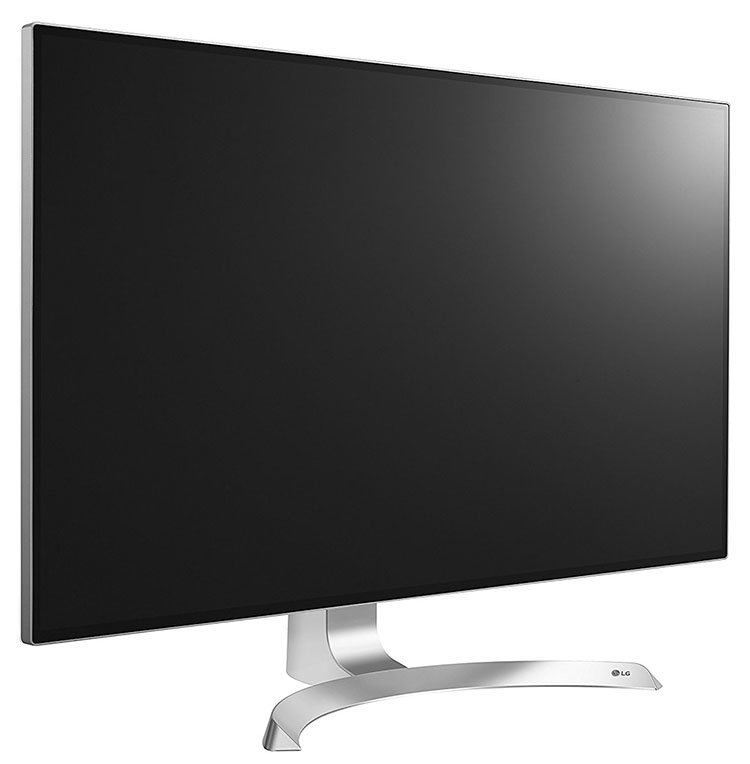Early Verdict
The LG 32UD99 has no significant flaws. It’s not really a gaming monitor but includes FreeSync anyway. Until more Ultra HD screens are available at faster refresh rates, displays like this will be better-suited to video and static content. In that regard, this monitor is superb. It offers great out-of-box accuracy and correctly-implemented DCI-P3 and Rec.709 color gamuts. And it does a respectable job with HDR10 content at a relatively low cost.
Pros
- +
Ultra HD
- +
DCI-P3 color
- +
Out-of-box accuracy
- +
sRGB & Rec.709 gamut options
- +
Good contrast
- +
HDR10 & FreeSync support
Cons
- -
60Hz limit
- -
No swivel adjustment
Why you can trust Tom's Hardware
Features & Specifications
Not long ago, Ultra-HD monitors were a big deal, with even bigger price tags. Now it seems, they're somewhat passé unless they also include extended color and HDR support. Users have quickly discovered that resolution alone is not enough to ensure premium image quality. The extra contrast afforded by HDR, coupled with color gamuts extending out to the DCI-P3 standard make a striking difference when viewing the latest video and gaming content.
That said, creating good HDR is a challenge with LCD technology. Its native contrast is inherently low compared to plasma or OLED technologies. LCD simply can’t produce the deep blacks of those inherently emissive technologies. Dell found a good formula with the Dell UP2718Q we reviewed recently. By including a multi-zone backlight, it can create tremendous dynamic range, with static contrast scores exceeding 17,000:1.
LG is taking a simpler approach with its 32-inch, 4K-resolution 32UD99. Its backlight is arrayed at the edge like most computer monitors and televisions, but uses the highest-contrast IPS panel we’ve seen to date, rated at 1300:1. While it won’t deliver the deep blacks of a VA panel, it manages to beat out most of the competition in both performance and value. Let’s take a look.
Specifications
The 32UD99 has similar specs to many high-end consumer televisions--3840x2160 resolution, extended color, and HDR10 support. But to that, it adds from-the-factory calibration for both DCI-P3 and Rec.709/sRGB gamuts. It also has a built-in auto-calibration feature courtesy of LG’s True Color Pro software. Making use of the latter feature requires buying additional software and a color meter kit from LG. But fortunately the out-of-the-box preset gamuts are quite accurate--enough so that calibration is not required.
For around $1,000 at this writing, those specs would be enough for us to declare the 32UD99 a good value. But there is FreeSync support here as well. Granted, its 40-60Hz range won’t knock any gamers socks off (and you'll of course need a compatible AMD graphics card to use it). But even the beefiest graphics boards won’t drive the action at much higher frame rates than that for the most demanding AAA titles.
LG bills the 32UD99 as a professional screen, and that makes sense given its emphasis on accuracy. We’ll perform our usual tests for both SDR and HDR performance, and we’ll take a look at the HDR Effect mode which adds a little extra punch to standard material. We’ll also play a few games to see how FreeSync enhances the experience.
Packaging, Physical Layout & Accessories
The monitor's packaging is stout and sturdy, well up to protecting the 32UD99 from the rigors of shipping. Our sample arrived unscathed, despite having obviously been shipped more than once. The display arm bolts to a solid-metal base, then snaps onto the panel. Bundled cables include DisplayPort, USB-C with an adapter, and HDMI. These and the large power brick are finished in white to match the panel, and come nicely packaged in their own box. You also get a calibration data sheet, the accuracy of which we confirmed with our tests. A user manual is available on LG’s website.
Get Tom's Hardware's best news and in-depth reviews, straight to your inbox.
Product 360
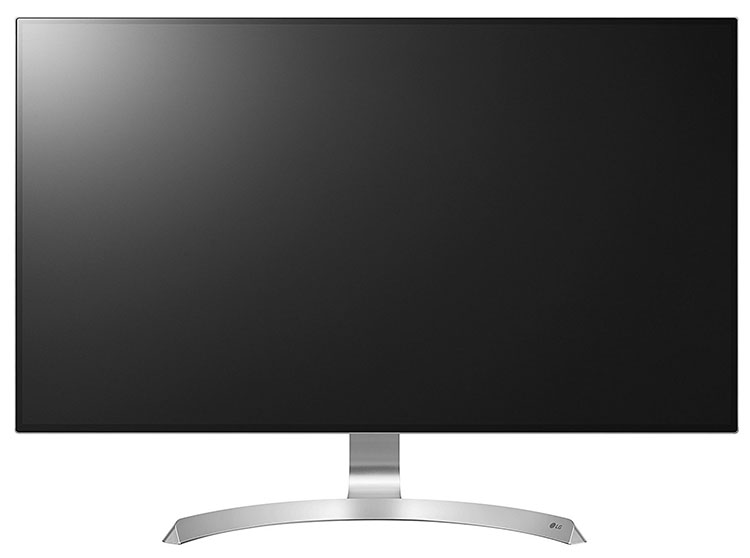
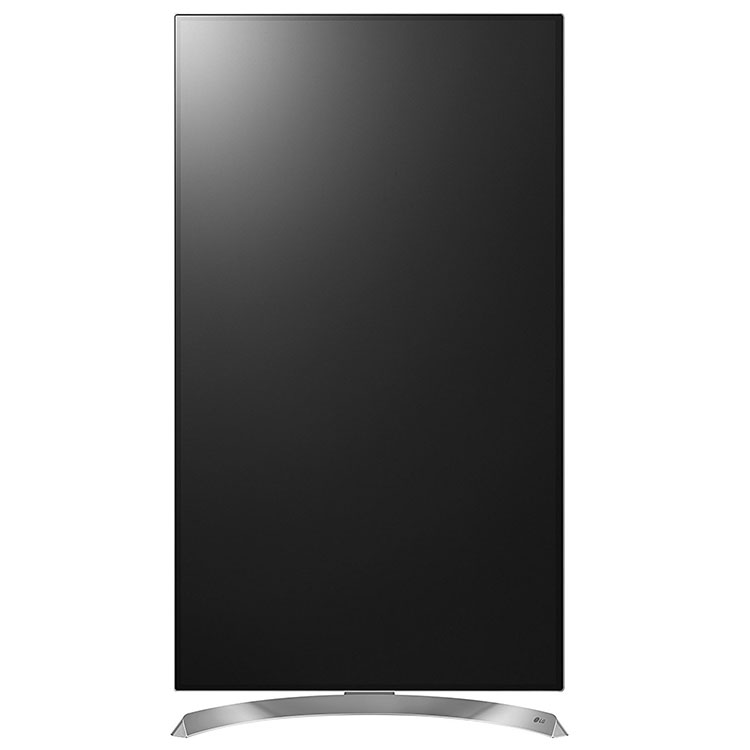
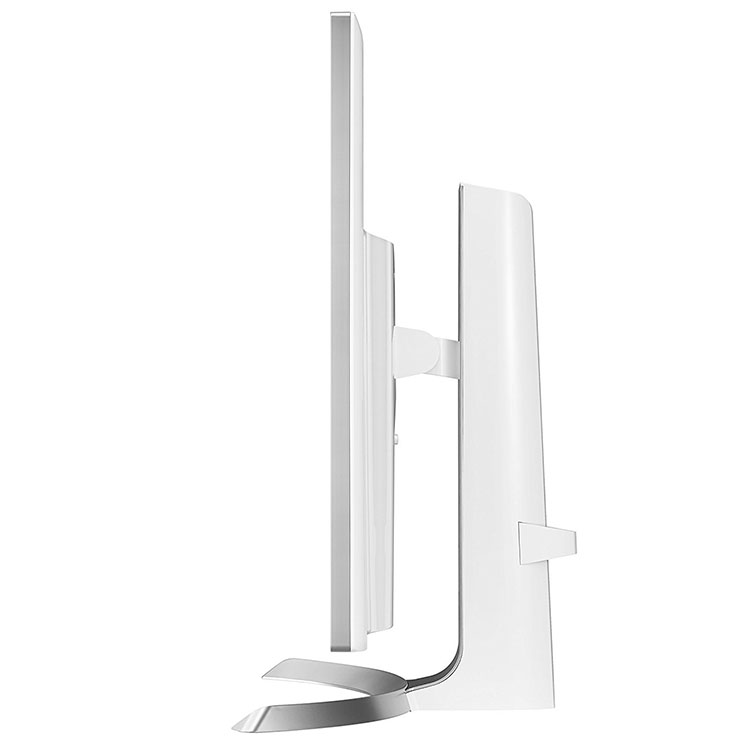
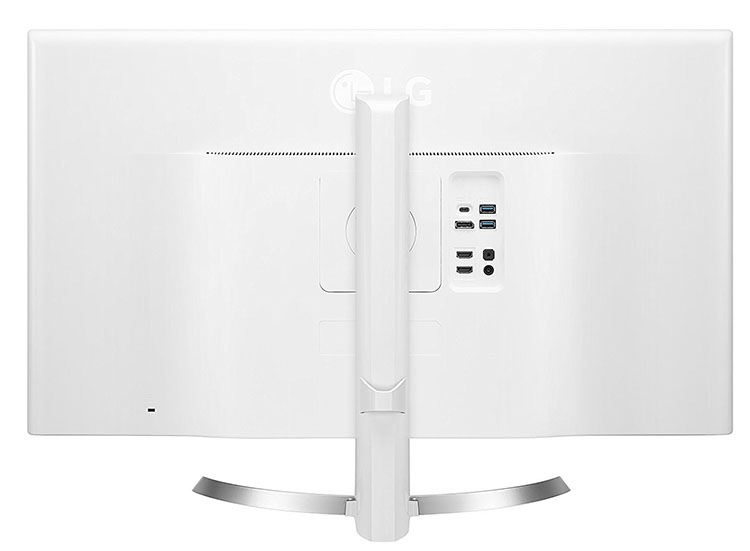
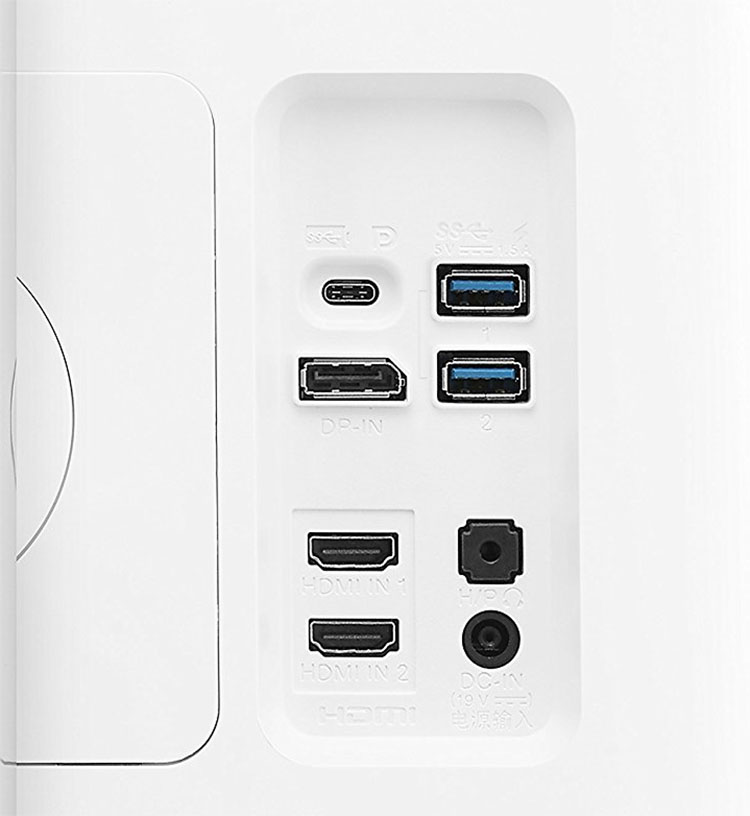
LG is one of the only display companies to feature white trim on many of its products. It’s a nice break from the industrial black seen nearly everywhere today. No wonder the company's screens are popular with Mac users. From the front, the image is framed by a thin 7mm bezel. The arm is all-white while the minimalist base is made from cast aluminum, finished in a satin texture. The stand mechanism looks small but is more than up to the task of keeping the nearly 20-pound display stable. The anti-glare layer is similar to other monitors of this class and provides grain-free clarity with good light control.
The stand is solid and adjusts without any play or wobble. There is no swivel, but you do get 4.5” of height, along with 2° back tilt, 15° forward, and portrait mode (rotating the screen 90°). A small clip (white of course) is included to help with cable management.
All monitor functions, including the power toggle, are controlled by a single joystick/button combination. LG is a master of this particular user interface, and we love it (at least compared to less-friendly button-only interfaces). A single press turns on the juice. A second click brings up a quick menu, and a right-click opens the OSD. Navigation is simple, quick, and intuitive. Also on the bottom are two small grills for the five-watt speakers. They play with a bit more bass than most, and manage decent volumes without distortion. But most gamers and movie watchers will of course want external speakers.
The monitor's back is a sea of shiny white plastic, broken only by a small rear-facing input panel. You can remove the upright to expose a 100mm VESA mount. And the panel is quite slim, less than two inches thick. Everything has a premium look and feel from the styling down to the stand movements.
Inputs include a single DisplayPort 1.2, plus two HDMI 2.0 ports with HDCP 2.2 content protection. That last spec is a requirement for HDR10. USB is supported by a Type-C jack and two v3.0 downstream connectors. Analog audio is carried by a headphone jack that can also be used with powered speakers. The last plug on the lower right is for the external power brick.
MORE: Best Gaming Monitors
MORE: How To Choose A Monitor
MORE: All Monitor Content

Christian Eberle is a Contributing Editor for Tom's Hardware US. He's a veteran reviewer of A/V equipment, specializing in monitors. Christian began his obsession with tech when he built his first PC in 1991, a 286 running DOS 3.0 at a blazing 12MHz. In 2006, he undertook training from the Imaging Science Foundation in video calibration and testing and thus started a passion for precise imaging that persists to this day. He is also a professional musician with a degree from the New England Conservatory as a classical bassoonist which he used to good effect as a performer with the West Point Army Band from 1987 to 2013. He enjoys watching movies and listening to high-end audio in his custom-built home theater and can be seen riding trails near his home on a race-ready ICE VTX recumbent trike. Christian enjoys the endless summer in Florida where he lives with his wife and Chihuahua and plays with orchestras around the state.
-
Tanquen Just some random thoughts. Not sure I’m keeping it. (Returned it as the image would black out randomly and the other issues below)Reply
The included cables are way too short. Better than nothing but you best be using them with a laptop right next to the display. They should have done better on a $1k display. It seems they had to make the USB-C cable beefy and short as my other USB-C cable that I just upgraded to because my new Pixel 2 don’t like the poorer(?) quality older ones I had that worked fine with the Pixel 1 don’t work with the LG. The calibration has issues with the included USB and even the Windows app had issues.
The USB connection, while troublesome did finally work and the screen adjustment app is cool and I was able to update the displays firmware. Never done that with a display before.
It’s flat screen! Yeah! Not sure why everyone seems to be into pinching the middle of the screen and flaring the corners when we finally got rid of this type of distortion moving from CRTs?
It’s 16:9. Boo. The only option for 16:10 are other 30” displays like the newer U3017 but none I can find with a res higher than 2560x1600.
The Vesa Mount. It has one but it’s off center and mounts too high on my Ergotron arm. Boo! I know they want to put the hardware and stuff low on TVs and such too make the top look so thin but I’d rather have the vesa mount centered. Looking at getting a new TV and will have to redo the wall mount. :(
May try one of these on this display:
https://www.ergodirect.com/product_...x9_SZgwtY21GVa1c8oSqP8r4Gzk06RQUaAgHTEALw_wcB
https://www.newegg.com/Product/Prod...cCdSXCAMdHOdAebexS8aAlaNEALw_wcB&gclsrc=aw.ds
Size. Not a full 32” but that is how they do it. The small bezel is nice. No logo is nice too but, the display adjustments are on the bottom and this limits your multi mount options.
Built in speakers. Not the best sound but handy if you move the monitor around or in years to come when you just want simple sound without setting up extra speakers.
Anti-glare coating. Maybe it gets them a brighter screen but the LG shows way more than the Dell. Not mirror like but I see lots of light sources like me and my desk in the LG.
The display was shipped in a metallic bag with a lining but no extra screen protection. There are some permanent spots seen when cleaning and it’s much harder to clean. Like the coating is more porous. It took me some time to clean my finger prints off. Never wanted a pair of kit gloves before.
Calibration. The whites are more so then the Dell but a bit blue for me. The built in calibration sounded good but it’s next to imposable to get running and when you do, it adds banding.
Power. See this more and more but it has an external AC adapter. So my existing power cables won’t work. I did find an IEC Socket C14 to Cloverleaf Plug C5 Adapter but still had to mount the power brick.
It has some response time adjustments but I can’t see the difference between any of them and the motion blur is noticeably worse than the seven year old Dell.
Freesync. Glad it has it but can’t seem to get it to work.
HDR. Again, glad it’s there but none of the games I have support it and I can’t see anyway to play an HDR video to try it out. :(
The extra res is good and bad. The Dell U3011 30” at 2560x1600 is a good spot to be as I can run at 100% PDI and still read everything. With the new 4k display I’d need it to be 40” or something. With this 32”-ish display I have to up the DPI and still in 2018 Windows 10 has some issues scaling windows. Some apps or windows ignore the DPI setting or look like scaled bitmaps.
The IPS Glow is a bit worse than the 6-7 year old Dell but this may have something to do with the coating and the much greater focus on brightness and HDR. It takes some getting used to. The whites are also a bit blue.
And twice today there was a slight popping sound and an onscreen glitch to go with it. Got it from B&H for $880 or so and it's a good price at the moment. So, I can return and wait for them to get them in stock again or just return it. Thinking I should just return it.
Can't even try out Netflix 4k HDR as AMD has no Display Ready 3 or whatever. :(
Overall, I'm disappointed. The one game I could try with HDR (Hitman) seems like nothing changes with it on but you can’t just toggle it back and forth.
Freesync also doesn’t seem to work and it has more motion blur eventhough its listed as being faster than my old displays.
-
davidgirgis "Between the product photos and the different logos that appear, one can make out just what the LG expect the display is be doing."Reply
Is this English? -
AnimeMania Which video ports can be used for Freesync? Does HDR require certain video ports or can any be used?Reply -
Ilya__ Reply20749782 said:"Between the product photos and the different logos that appear, one can make out just what the LG expect the display is be doing."
Is this English?
People think the products not be like it is, but it do. -
hannibal It seems to be Vesa HDR400 monitorReply
https://displayhdr.org/performance-criteria/
Because max brightness is less than 600 nits. But it is close to it. So it is almost Vesa HDR600 compatible -
truerock I hate it when they put speakers, USB ports and other unrelated crap inside a video monitor. I wish they wouldn't do that. I like the trend that Samsung is starting with its TVs where all the ports and other non-video-monitor stuff is put in a separate box.Reply -
lukwtwz How did you measure total input lag? I ask because the 65ms you reported is several times higher than the highest figure reported in any professional review of this monitor I've read so far.Reply
